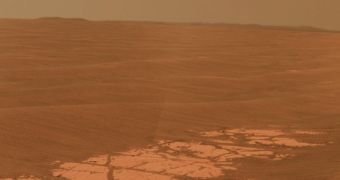Scientists at the NASA Jet Propulsion Laboratory (JPL) in Pasadena, California, announce that Opportunity snapped a new image of its destination, the Endeavour crater on the surface of Mars. The small explorations robot has been traveling on the surface of the Red Planet for more than six years, and mission managers say that this particular crater will most likely be its last stop. However, the landscape feature is still very distant for the machine.
Though Opportunity has recently exceeded the 20-kilometer mark on Mars, it covered this distance in many years. It still has some 13 kilometers, or 8 miles, to go until it reaches the Endeavour crater. In its defense, the machine spent the better part of two years studying Endurance crater. Scientists are reserved in stating that this distant goal will be achieved, but they add that the vast majority of systems on the Mars Exploration Rover (MER) are operational, which is a good indicator that the machine will endure for a little while longer.
Moreover, Opportunity does not have to hibernate during the harsh months of Martian winter, like Spirit has to. It roams the planet at a latitude a lot closer to the Equator, which allows it to continue functioning around the year. However, getting to Endeavour may be hindered by finding additional rocks in its path that could be of interest. Throughout its journeys, the robot has encountered several meteorites, which it spent months analyzing, for more data on how the past climate of Mars looked like.
At the end of March, the rover finished exploring Concepción Crater, a peculiar landscape feature that exhibited materials never encountered around the robot's landing site. “One consideration that jumps out is that we've been driving around this part of Mars for six years and never seen this stuff before, then we get to this young crater and it's coating rocks all around the crater. Sure looks like there's a connection, but it could just be a coincidence,” Matt Golombek, who is a member of the JPL science team managing the two rovers, says.
“It was clear from the images that Opportunity took on the approach to Concepción that there was strange stuff on lots of the rocks near the crater. There's dark, grayish material coating faces of the rocks and filling fractures in them. At least part of it is composed of blueberries jammed together as close as you could pack them. We've never seen anything like this before,” the principal investigator for the MER mission, Steve Squyres, states. The expert holds an appointment at the Ithaca, New York-based Cornell University. He is the person in charge with analyzing the data that Opportunity and Spirit send back from Mars
Also in March, Opportunity got a new software upgrade that enabled it to become more autonomous, and able to select targets of geological interest all on its own. Even now, the machine is able to analyze images it collects with its wide-angle cameras, and analyze them with its computers. If it discovers rocks, which meet certain criteria (roundness, coloring), it can then decide to stop, and move in for a closer look. This reduces the burden of human controllers, who may take up to several days to find things of interest in the images the rover sends back. They then have to backtrack the machine, thus losing time.

 14 DAY TRIAL //
14 DAY TRIAL //